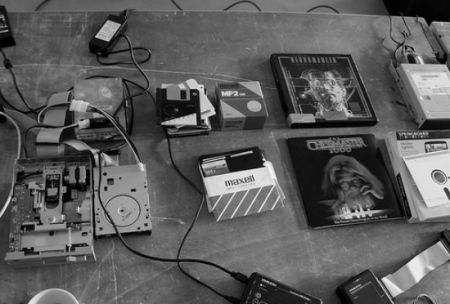Resurrection Lab, the resurgence of digital art
Preserving CD-ROM collections of digital works of art and other born-digital content is a complex task. And until recently, there’s been a lack of knowledge about useful methods, tools and services in this field. Meemoo and iMAL therefore carried out research into the subject in the Resurrection Lab project, with financial support from Innoviris (the Brussels Institute for Research and Innovation).
Challenge
Access to complex digital objects (such as digital works of art) often relies on rapidly ageing software and hardware, which can make preservation very tricky. This problem exists for digital works saved on CD-ROM, such as those in the iMAL collection, but also for content stored on a number of other outdated carriers, such as CD-Rs, CD-RWs, Zip disks, SyQuest technology, magneto-optical drives, and 3.5-inch and 5.25-inch diskettes.

CC BY SA meemoo - various reading devices and carriers
Is emulation the solution?
One efficient way to ensure access to these digital creations is emulation: a technique that uses software to simulate a hardware platform. The contents of a CD-ROM, for example, can be captured and transferred to a modern, sustainable data carrier. Emulation software can then display this content as it appeared originally, but in a modern hardware environment. Knowledge about this technique is still limited in the cultural heritage field, however, which is why we wanted to plug this gap together with Resurrection Lab.
Our role
You need old reading equipment connected to a modern computer to capture content from old carriers. We therefore acquired reading equipment for the most common outdated carriers, and set up a capture station with various configurations for old carriers. We then published workflows for capturing the content and migrating it to modern data carriers on our CEST knowledge platform. In a later phase, we designed a data model customised for the publicly accessible media library for part of iMAL’s CD-ROM collection.
Approach
Assembling and testing the capture station
The capture station consisted of a laptop connected to various reading equipment – a set-up that’s described in detail in the capture station documentation – and tested it with a collection of CD-Rs, CD-RWs, Zip disks, SyQuest technology and magneto-optical drives from Opera Ballet Vlaanderen, and with 3.5-inch and 5.25-inch diskettes from Liberas, ADVN and House for Electronic Arts (HeK - Switzerland). This resulted in the publication of a number of detailed practical examples on the CEST knowledge platform.
Capturing the iMAL collection
The iMAL collection that served as the starting point in this project consisted of 300 CD-ROMs. The first step was to put them all in order and number them. We then captured all the content and saved it securely on the server with subsequent quality controls, which also ensured we had a good basic record of all the CD-ROMs. iMAL drew up a strategy for saving the data securely in advance of the actual capture and storage.
Making the collection accessible
In order to make the collection easily accessible, more than just a few basic details need be registered for each carrier and creation. iMAL therefore wrote up an analysis of the requirements, functional specifications and user interface design for the daCMS – the system used for describing, managing and providing access to the collection. The data model, consisting of terms and their mutual relationships, is an important element of this.
We therefore designed a data model, based on the requirements and existing models, to describe works of art on outdated media. This data model was then included in the development of the management and access system, particularly in the underlying database structure.
iMAl installed two servers and four computers as the infrastructure for this management and access system, and familiarised itself with the EaaS/bwFLA/EMil framework designed at the University of Freiburg. Following a workshop with the team from bwFLA, it was decided that the CMS system should be fully customised for this project. The daCMS was therefore developed further in Symfony/PHP into an almost fully functional prototype for describing and providing access to the collection.
Finally, the collection was made accessible by the integration of the daCMS with the emulation framework EaaS/EMiL.
Results
Meemoo acquired lots of knowledge in this project, which it has shared on CEST:
iMAL described the entire workflow for the CD-ROM collection – capturing data from a CD-ROM, describing the (digital) object in the daCMS, and providing online access to the object with metadata – in the document ‘Digital Preservation Workflow User Guides’.
This entire workflow has already been successfully completed for around 20 important works from the collection. These CD-ROMs can be accessed by emulation, so you can see them appear on a modern platform as they were intended when they were created in the 1990s. You can also access all the available data about the works. It has also been possible to import some metadata from around 250 other CD-ROMs, and prepare the emulations, but some of the descriptions still need to be completed.
Meemoo is continuing to manage the reference station for capturing the most common obsolete carriers after the end of the project (February 2019), which has helped some organisations to capture content from old carriers in their collections. This station consists of a laptop, a number of reading devices and various cables and attachments, and has been expanded further with reading devices for Zip disks, 3.5-inch HD diskettes, magneto-optical drives, SuperDisk, optical disks, DDS tapes and Travan Tapes, amongst others, in the framework of the ‘Digital Repair Cafe’ project. The user guides for processing these carriers have been added to CEST and compiled in an English version of the website for this project.
Partners
iMAL and meemoo took the initiative for the Resurrection Lab project, with financial support from Innoviris (the Brussels Institute for Research and Innovation).
During the implementation of the project, expertise was called upon from the employees at LiMA (Amsterdam), Tate (London), Hek (Basel), Albert-Ludwigs-Universität Freiburg and Rhizome (New York).
